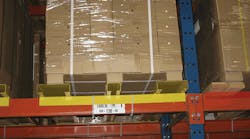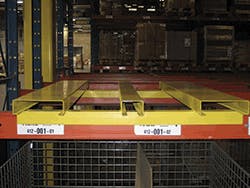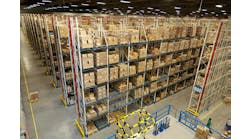It is not unusual for a large product manufacturer or retailer to utilize millions of pallets each year for warehousing and shipping products between manufacturing, distribution centers and retail stores. For the past 70 years, pallets have been primarily made from wood. Within the United States alone, 1.2 billion wooden pallets carry 93% of all goods shipped.
But the interest in alternative solutions to the use of wooden pallets has continued to escalate as companies search for more cost-efficient shipping options, increased product safety and a more sustainable supply chain. This is particularly evident in the food and pharmaceutical industries, and where shipping by overseas containers is prevalent.
Contamination Concerns
Contamination from wooden pallets to food and pharmaceutical products is a very real concern. Wooden shipping pallets that transport food and pharmaceuticals have been discovered carrying bacteria and life-threatening pathogens, a claim supported by the U.S. Food and Drug Administration and the U.S. Department of Agriculture. Pharmaceutical manufacturer Pfizer had to recall some of its Lipitor cholesterol drug supply due to contamination from the wooden pallets it was shipped on, and Johnson & Johnson had troubles with its Tylenol product after being exposed to a moldy smell caused by a fire retardant chemical treatment used on wooden pallets.
Wooden pallet contamination from pests is an increasingly serious concern for U.S. government agencies, importers and trans-state shippers. California has intercepted dozens of infested wooden packaging materials from cross-state shipments in recent years, according to APHIS. Quarantines for pests from wooden pallets exist in parts of New York, New Jersey, and the mid-Atlantic and Midwest states, creating confusion and compliance challenges for businesses' distribution of imported products and trans-state shipments.
Then there are sustainability issues with wooden pallets, which require massive amounts of lumber and trees to be produced. A standard GMA or Euro wooden pallet, weighing in at approximately 55 pounds, occupies shipping space in containers and truckloads, and consumes fuel to be transported. When sustainability measures are strategically planned and implemented, a manufacturer or distribution facility could realize a significant reduction in operating costs, while benefiting from the positive satisfaction and recognition that sustainability generates.
Paper Slip-Sheets
Manufacturers and distributors worldwide, especially in the food packaging and pharmaceuticals industries, are assessing how they can cost-effectively replace wooden pallets. One option, which has become increasingly visible in distribution applications, is the use of paper slip-sheets. Consisting of a corrugated sheet with two split corrugated cores (tubes) to accommodate lift truck forks, they can support up to 2,800 pounds. There are many widely-used types of slip-sheets, available in different gauges of paper material—such as heavy, laminated paperboard or corrugated fiberboard—that are specified depending on the load weight requirements.
Once a load is built on a paper slip-sheet, it is stretch wrapped for stability. Paper slip-sheet loads sit lower to the ground: 2" above the floor compared to 4" for wood pallets. To maneuver slip-sheet loads throughout warehouses, forklift trucks can be outfitted with carton clamps or special-purpose forks, which are designed to be inserted easily under the load (one example being RollerForks, made by MSE-Forks BV, www.mse-forks.com).
Not only recyclable, the costs of paper slip-sheets are significantly less, ranging from $1-$3 each, compared to $17-$20 for wooden GMA and Euro pallets. The benefits of paper slip-sheets come from sizably reducing wooden pallet costs, but also from reduced shipping costs because of better loading density. The volume of space utilized in each shipping unit is reduced because the pallets are no longer taking up space, so more items can be transported through the supply chain within a shipping container or truck.
By employing paper slip-sheets, companies can realizes a 12% to 15% improvement in space utilization within their containers and truckloads. The sustainability benefit is also credible, as eliminating millions of wooden pallets saves trees, and better optimized loads in shipping reduces the number of truck trips, cutting fuel consumption and emissions.
The Palletless Supply Chain
Although paper slip-sheets provide an economical solution for many manufacturers' container and trailer shipping needs, they have been confined to use in shipping only; storage has not been an option. Slip-sheet loads that are brought into a warehouse facility via container or truckload must be loaded onto wooden pallets to be put into low-bay storage. When these loads leave the warehouse, they are removed from the pallets and loaded into a container or a truck for shipment. Like all standardized pallet racking systems, rack structure is set up to accommodate wooden pallets, not paper slip-sheet loads.
To fully embrace the benefits of paper slip-sheet loads, current low-bay distribution center infrastructure—conventional low-bay racking for pallet storage—would need to be adapted to accept such loads. Such a solution, if put into place, would permit a seamless throughput of paper slip-sheet loads from receiving, through storage, and out through shipping without having to palletize and de-palletize the loads. It would completely eliminate the need for wooden pallets in low-bay storage.
Warehouse Solutions Plus Inc. (www.wsplusinc.com), an integrator specializing in warehouse racking systems, moved forward to engineer a rack decking solution that would accept paper slip-sheet loads without needing to be placed on wooden pallets. Its focus centered on the low-bay rack decking, which needed to be modified to support the weight of the paper slip-sheet load, yet provide adequate space to allow entry of the forklift tines under the load.
Low-bay rack supports, which are traditionally found on the underside of the deck, were repositioned onto the top of the deck and along the sides, and a riser deck was integrated, allowing the same strength and stability, but with added functionality. The metal riser deck, developed by Riser Deck (www.riserdeck.net), can be custom-designed to conform to the load requirements of specific applications, permitting greater storage capacity and space utilization. Where wooden pallets would conventionally serve this function, with such pallets eliminated, storage costs are reduced and eliminating wooden pallets supports sustainability.
The decking can also be modified to also accept standard GMA pallets, requiring a 4" height clearance to accept forklift standard tines.
In the process, Warehouse Solutions Plus engineered several prototype designs for furniture retailer IKEA USA distribution centers to accommodate that company's low-bay storage locations for its paper slip-sheet loads. By introducing this solution, IKEA (www.ikea.com) has completed the task of removing pallets from its low-bay storage. In addition to sustainability benefits, the company expects to save tens of millions of dollars annually, within just its U.S. distribution operations, simply by eliminating wooden pallets in shipping.
These modified racking systems, with the metal raised decking, can deliver noticeable benefits to distribution operations. Not the least of which is a reduction in damages, both to the racking as well as to products, due to the raised-decking aspect of the design.
With the advent of this new palletless low-bay raised-decking system for paper slip-sheet loads, it completes the connection of a continuous supply chain—from manufacturing outbound in overseas containers or domestic truckloads, to receipt in DCs and put-away into low-bay storage, and then outbound for shipping, without the need for repositioning onto wooden pallets. If retail stores are being shipped to from a DC, their backroom warehouses can also be equipped with these modified decking systems to accommodate for paper slip-sheet loads, further extending the palletless supply chain.
Logistics executives are under continual challenge to optimize their supply chains. Integrating streamlined distribution technology, creating smarter work processes that increase efficiency and maximize labor utilization, and employing more cost-efficient shipping modes—these factors are critical to a successful supply chain structure that lowers operating costs and improves profitability for their distribution operations. It requires a continued focus on the fundamentals of supply chain distribution that many companies take for granted. Strategically, the importance of palletless shipment and storage, as a central element in today's material handling environment, is one that logistics executives cannot afford to ignore.
Jim McMahon writes on supply chain innovation.




